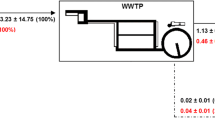Abstract
Presence of organic compounds from cosmetics, detergents or pharmaceuticals found in wastewater is mainly a consequence of human activity. In wastewater treatment plants (WWTPs) removal of these pollutants takes place as secondary treatment in the aeration tank. An important parameter in this treatment is hydraulic retention time, which represents the treatment period in the aeration tank, recommended for most systems of 4 to 8 h. Also, several mathematical models were developed to determine the fate and removal efficiency of organic compounds in WWTPs. One of the most used is the SimpleTreat model (“9-box” model) which was created by the National Institute of Public Health and Environment in Netherlands (RIVM). The model considers 9 compartments or boxes in which the primary settler, aeration tank and secondary clarifier of a WWTP are contained separately. Each basin has a liquid (water) and a solid phase (suspended solids) in which the pollutant may be dissolved and/or adsorbed, respectively. Estimations of the organic compound concentration values may be determined in each WWTP basin and also discharged via effluent. All values are expressed in percentage from compound nominal concentration in influent representing the removal efficiency. This study presents estimations with the SimpleTreat model of the removal efficiency of six organic compounds found in products as: cosmetics—Tonalide (AHTN), decamethylcyclopentasiloxane (D5) and edetic acid (EDTA); detergents—benzalkonium chloride (BAC) and pharmaceuticals—Permethrin (PMT) and Atenolol (A). Depending on their chemical properties, these compounds may be found in influent mostly dissolved in the liquid phase or mostly adsorbed on the surface of the suspended solids. The removal efficiency is evaluated after 2, 5, and 10 h of retention in the aeration tank.




Similar content being viewed by others
REFERENCES
Tchobanoglous, G., Burton, F.L., and Stensel, H.D., Wastewater Engineering: Treatment and Reuse, New York: McGraw-Hill, 2002, 4th ed.
Franco, A., Struijs, J., Gouin, T., and Price, O.R., Evolution of the sewage treatment plant model SimpleTreat: Applicability domain and data requirements, Integr. Environ. Assess. Manage., 2013, vol. 9, no. 4, pp. 560–568.
Lautz, L.S., Struijs, J., Nolte, T.M., Breure, A.M., Grinten, E., Meent, D., and Zelm, R., Evaluation of SimpleTreat 4.0: Simulations of pharmaceutical removal in wastewater treatment plant facilities, Chemosphere, 2017, vol. 168, pp. 870–876.
Struijs, J., SimpleTreat 4.0: A model to predict fate and emission of chemicals in wastewater treatment plants. Background report describing the equations, RIVM Report 601353005/2014. http://www.rivm.nl/bibliotheek/rapporten/601353005.pdf.
Chemicals databases PubChem and eChemPortal. https://pubchem.ncbi.nlm.nih.gov/; https://www.echemportal.org/.
Author information
Authors and Affiliations
Corresponding author
Ethics declarations
The author declares that she has no conflicts of interest.
About this article
Cite this article
Mihaela Flori Influence of Hydraulic Retention Time on Organic Pollutants Elimination from Wastewater. J. Water Chem. Technol. 44, 232–235 (2022). https://doi.org/10.3103/S1063455X22040075
Received:
Revised:
Accepted:
Published:
Issue Date:
DOI: https://doi.org/10.3103/S1063455X22040075




